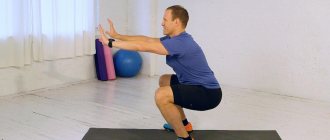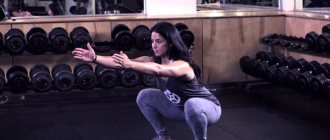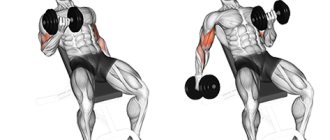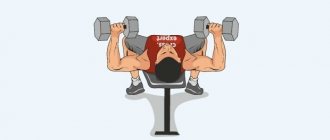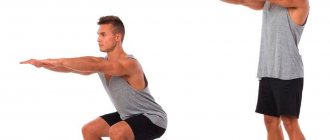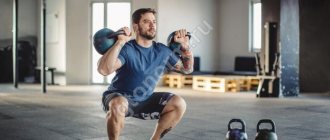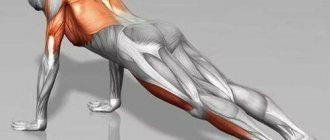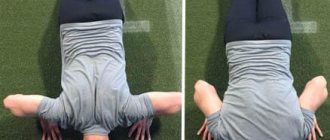What should a girl do if she is a “complete zero” in the gym, but really wants to pump up her butt. There is only one answer - experiment. Today we will look in detail at one atypical exercise. Namely, knee squats. And we’ll find out how effective it is and whether it’s worth including it in your training program.
Of course, when a girl comes to the gym to pump up her buttocks, any trainer will immediately prescribe her a classic squat. In the end, it turns out that she wanted to enlarge her butt, but got bigger legs. This situation occurs very often.
And this doesn't mean that squats are a bad exercise. Everything is poison and everything is medicine. In other words, we need to feel exactly what we are doing in this or that exercise. The classic squat with an emphasis on the buttocks is a difficult exercise to perform.
Therefore, if you are new to exercise machines and exercise without a trainer, then it is better to pay attention to easier exercises. Kneeling squats are just one of them.
What muscles work
Knee squats can be classified as both basic and isolated exercises that are aimed at working the buttocks.
The complete atlas includes the following muscle groups:
- targeted – gluteus maximus;
- synergists - quadriceps, hamstrings, rectus abdominis, spinal extensor muscles.
Specifics and contraindications
Kneeling squats with weights are specific exercises that should be used to comprehensively work the muscles of the legs and buttocks. They are not used to build muscle mass. Other functional exercises, such as lunges, are better suited for these purposes.
Kneeling squats have some contraindications. They should not be performed in case of spinal or knee injuries. Also, the exercise is not suitable for beginners. To increase the comfort of movement, you can use soft knee pads.
Benefits of Knee Squats
Knee squats have some advantages over classic squats:
- enlarge the buttocks without enlarging the legs;
- develop strength in the hips and buttocks;
- help overcome the “plateau” in basic squats;
- relieve stress from knee joints;
- strengthens the muscles of the lower back.
Note. This exercise is classified as “explosive”, which allows it to be used in a type of training such as pumping. The purpose of which is to fill the muscles with blood and, as a result, inflate them, which will make them visually larger.
Now let's talk about squats
As I already said, this exercise consists of two movements: extensions in the hip and knee joints. The main role in this movement is played, oddly enough, not by the quadriceps, but by the gluteus maximus muscle. It not only extends the hip joint, but also helps the quadriceps to extend the knee. Let's see how this happens.
Imagine the rectus femoris muscle as a piece of inextensible rope attached to the pelvic and tibia bones. When the hip joint extends, the load, while remaining tense, transfers force to the lower leg, helping the single-joint muscles: lateral, medial and intermediate to straighten the knee joint. The task of the rectus femoris muscle is to remain tense and transmit the force created by the gluteus maximus, which extends the hip joint. In this case, the force generated in it is somewhat less than in single-joint mice. By the way, the efforts in all four heads of the quadriceps will be equal when extending the legs in the simulator.
The load on the biarticular muscles of the back of the thigh is less than on the gluteal. Their length remains almost unchanged. They should not contract significantly, as this will interfere with the extension of the knee joint. Apparently, their role is limited to joint stabilization.
Technique for performing knee squats
The exercise falls into the “easy as pie” category, but it also has some features. The technique is as follows:
- Set the bar to the desired height.
- Place the folded mat on the floor under the bar.
- Get down on your knees with your shins parallel to each other, shoulder-width apart.
- Place the bar behind your head at the bottom of your trapezius and remove it from the supports.
- Squeeze your shoulder blades and tighten your abs.
- As you inhale, begin to move your buttocks back until they touch the muscles of your lower leg (if stretching allows, you can go lower).
- Without pausing, exhale and return to a vertical position.
- Repeat the exercise a specified number of times.
Before performing, be sure to do a warm-up, since this exercise puts a high load on the spine, namely the lower section. If the lower back muscles are tight, it will be difficult to lift weights.
On a note. Any squats, including kneeling ones, are best done after hyperextension. Your back muscles will be well warmed up and it will be easier for you to work with heavy weights.
Execution options:
- free weight knee squats;
- knee squats in Smith.
Knee squats can be done either with free weight or in a Smith machine (most often). In the first case, all muscle groups are better loaded. In the second, the gluteal muscles are better emphasized, since the movement follows a strictly given trajectory (at least many people think so).
Interestingly, the Smith machine was originally conceived as a simulator for working out lagging muscles. Then it was taken over by newcomers with unproven equipment. And now most of the exercises, including basic ones, are performed exclusively in Smith.
If we consider the trajectory of movement, which will be physiologically correct, then the bar should not go straight, but along an inclined path. That is, Smith squats cannot be technically performed correctly, where the load is vertical.
What to pay attention to
To make the exercise as effective as possible, pay attention to the following points:
- When squatting, go as low as possible to give your gluteal muscles a good stretch.
- Lower slowly and rise quickly by pushing out.
- Hold in the top position for 1-2 counts, squeezing your buttocks.
- Lower as you inhale, rise as you exhale.
- Keep your back straight at all times.
- Do not place your knees directly under the bar, but bring them slightly forward.
- Don't look down, look forward so as not to break your technique.
- Choose the right weight so that the exercise is effective and does not cause injury.
Recommendations
To make knee squats more effective, use the following tips:
- Breathing plays a key role in the quality of movement. It is the contraction of the diaphragm that allows you to maintain correct posture and removes excessive stress from the spine. Don't hold your breath, take deep breaths and full exhalations.
- Don't spread your hips out to the sides. Your knees should be strictly opposite each other and always look forward.
- During the break between approaches, it is better not to just rest, but to hang on the horizontal bar. This will stretch your lower back.
- The kneeling squat can be completed with a reverse hyperextension.
Thus, the knee squat is an excellent exercise for the buttocks and thighs, allowing you to exercise not only the large muscles, but also the small muscles. It develops neuromuscular communication well and, when performed regularly, gives tangible results. Due to the fact that the exercise is classified as traumatic, it should be performed with extreme caution.
How effective are knee squats for the buttocks?
According to some studies, knee squats have shown better results in the degree of gluteal muscle activity compared to other squats.
In theory, this may be true, but in practice, it’s better to try everything. Kneeling squats, although they are conditionally basic, are, in my opinion, worse than a classic squat with the pelvis pulled back and cannot provide the same effective muscle growth. To do this, just compare the angles in the classic version and in squats from the knees.
But such incomplete squats practically eliminate the work of the legs, which means that almost the entire load falls on the buttocks (albeit not so powerful). There is some advantage to this. And it’s difficult to make mistakes in this case.
Note. I would recommend this exercise more for inexperienced girls. And for those whose naturally quadriceps grow faster than their buttocks.
In general, basic exercises have always been and will be the best for building high-quality muscle mass (which will not go anywhere if you suddenly give up training for a month). Therefore, knee squats should be considered only as an addition to visually fill out the buttocks and give them shape.
How to choose your squat depth
It's simple - squat as deep as you can maintain the correct technique, namely:
- keepEffects of Squat Amplitude on Pelvic Tilt and Tibial Inclination_2017 keep your back straight at any point in the exercise and do not round your lower back;
- press your heels to the floor and do not lift them off at the bottom of the squat;
- When lifting, do not tuck your knees in or past your toes.
You can safely squat to any depth as long as these principles are followed. But as soon as your lower back begins to round and your heels lift off the floor, it’s time to stop.
Number of repetitions and sets
for weight loss
Multi-repetition training: 15-20 times in 3-5 approaches. You need to take a small weight in order to finish it to the end. Even an empty bar weighs 20 kg, which is a lot for beginner girls. Therefore, start simply with a body bar or 5 kg dumbbells. When the muscles get used to the load, increase the working weight.
for gaining muscle mass
Low reps (5-8) in 3-5 sets. The weight of the weight is sufficient to perform the required number of repetitions with the correct technique. But after the last repetition, you should have almost no strength left to do another one without rest. For beginner girls, it is better to start with a high number of repetitions to learn how to squat correctly and not get injured.
Overhead squats
This type of squat adds load to the upper body: the shoulders, trapezius, and trunk stabilizer muscles. Start with small weights and under the supervision of a trainer, as this exercise is very dangerous. First, warm up your shoulder joints with a stick or elastic band (as shown in the video below). The exercise is popular in CrossFit.
video - overhead squats for girls
Correct technique
- take the barbell in your hands with a grip wider than your shoulders and lift it above your head (do a barbell push);
- During a squat, the arms always remain in a plane perpendicular to the floor;
- do squats similar to front ones (keep your back as vertical as possible, with minimal forward bending).
For female beginners, it is imperative to first learn how to properly do regular squats before attempting overhead squats.
Warm up before exercise
Warming up is mandatory before every workout and barbell squats are no exception.
Warming up the muscles
The most important thing is not to get injured during the exercise, so first you need to properly stretch the muscles. You can run for 5-10 minutes at an easy pace or jump rope, or an exercise bike is also suitable.
Sit in a deep squat and spread your knees from the inside with your elbows, spring a little in this position, going deeper into the squat. Heels should be pressed to the floor. In a squat, place your hands behind your head and round your back, then bend deeply and finally lower yourself into a squat and place your right hand on your left foot, turning your body to the left and extending your left arm towards the ceiling. Repeat on both sides.
Exercises for joints
To develop joints, it is enough to twist your arms bent at the elbows and twist your legs at the knee and ankle joints. Make circular movements with your pelvis, spend about 10 minutes on these warm-ups.
Smooth transition to working weight
After a complete warm-up, you can begin exercises with a barbell. First, use a lighter weight than your normal working weight. Set of exercises:
- 10 times with an empty barbell;
- 7 times with half the weight of the working weight;
- 5 times with 75%
- 3 times with 90%.
Between warm-ups with a light barbell you can rest for thirty seconds, but with a working weight - a couple of minutes.
Common mistakes
Mistakes when doing Smith squats are similar to those people make when doing barbell squats:
- Strong deflection of the lumbar region and protrusion of the buttocks.
- Bringing the knees together.
- Large deflection in the thoracic spine.
- The position of the barbell is too high (on the neck).
As for Smith separately, the most common mistake is incorrect positioning of the legs. The feet are either carried too far forward, or placed under the bar or close to it. Having familiarized yourself with the correct technique, which I have already outlined to you, you should safely avoid all these mistakes.
Advantages of the machine
- Before moving on to free weight squats, it is recommended to master the technique on the Smith machine. The latter prevents the body from falling either backward or forward, thereby making the task easier and allowing you to better understand the algorithm of actions;
- The device allows you to exercise without a spotter, which is mandatory when working with free weights;
- The machine makes it possible to forget about maintaining balance - it is an indestructible fulcrum;
- This is the best simulator for practicing the technique of any squat;
- The Smith machine allows athletes with knee problems to do squats. It allows you to control the depth of the squats and the position of the legs;
- The device minimizes the risk of injury;
- In the simulator you can perform any exercises, not just those aimed at pumping your legs.
If you are interested in its shortcomings, there are practically none. Perhaps the simulator makes the task easier, but to grow muscle mass, the load should be constantly increased. Sooner or later you will have to leave the comfort of the rack and move on to free weight squats. Or you can simply gradually add other types of exercise (for example, hack lunges or the classic version with dumbbells).
.
